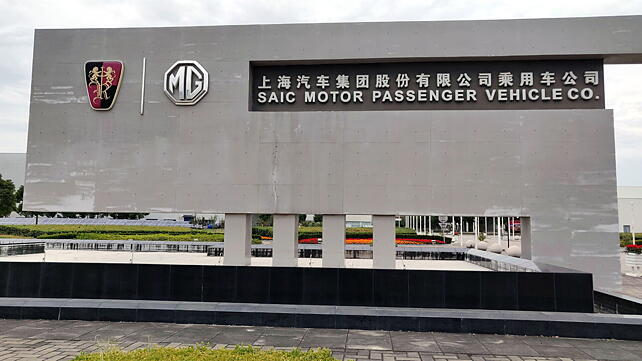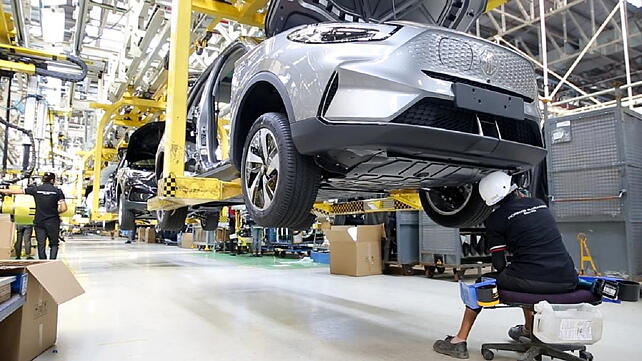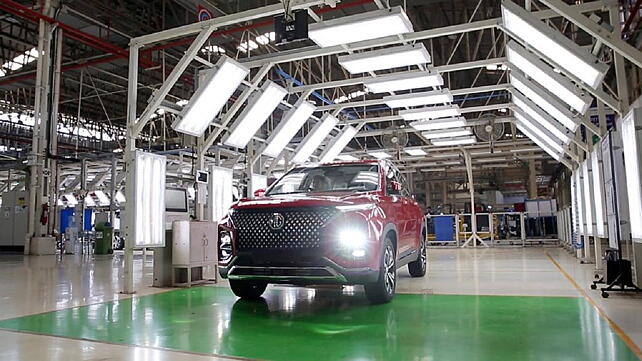
MG Motor India’s move to give a more local flavour to its shareholding structure marks an unusual departure by multinational car companies operating in the country.
Its parent, SAIC Motor, is the biggest carmaker in China and a formidable force to reckon with. The fact that it has agreed to divest a large part of its equity in favour of a host of Indian entities is interesting given that there is really no love lost between India and China at the political level right now.
In the process, the Centre has quite rightly put a freeze on new investments by Chinese companies which puts the likes of MG Motor (the front face of SAIC in India) in a bind. The company has ambitious growth plans but its parent will have problems investing in new capacities.
It was this limitation that prompted another Chinese automaker, Great Wall Motors, to shelve its proposal to acquire General Motors’ plant near Pune to kick off its India innings. The tensions along the border had its fallout on business sentiments and also led to Changan Automobile dropping its plans for the country even while it was scouting for potential locations in Tamil Nadu, Telangana and Andhra Pradesh.
MG Motor had entered this market earlier (in 2017) when it took over GM’s plant in Halol near Gujarat, revamped it in record time and then launched the Hector SUV. Over the last few years, it has built a strong connect with customers and is perceived as a smart, contemporary automobile brand.
Also Watch: MG Motor India: Blazing The Trail With Gender Diversity
Alternative Route
However, if it has to grow, there must be an alternative route to the conventional investment approach by its parent, SAIC, simply because of the tensions prevailing between India and China. A little over a year ago, reports were doing the rounds that the company was contemplating creating a new business vertical for electric vehicles aided by PE funding.
At that point in time, top industry sources were of the view that valuation would not be a problem. Apart from the fact that investors were kicked about EVs, this was the best way to take the India story forward for MG Motor. The valuation was rumoured to be in the range of $15 billion though there was no official confirmation coming in. Incidentally, Tata Motors and Mahindra & Mahindra had valuations of around $9 billion apiece for their EV businesses and both remain extremely upbeat about its prospects going forward.
In the case of MG Motor, its entire business — internal combustion engine and electric — will be part of the valuation exercise while roping in new investors. As per the press release issued on Wednesday, this is part of the effort to “Indianise the business operations for sustainable growth and meaningful impact on the society”.
The idea is to increase the Indian shareholding over the next 2-4 years apart from exploring cell manufacturing and clean hydrogen-cell technology “through owned or third-party facilities”. Beyond this, MG Motor will set up another plant at Halol which, in all likelihood, will be earmarked solely for EVs and boost overall vehicle output to 300,000 units annually.
Also Read: MG Motor India's 5-year Business Roadmap To Indianise Operations
All in all, investments will be over INR 5,000 crore and the company hopes to “achieve 65-75% of its sales from the EV portfolio by 2028”. It proposes to produce more EV parts locally and set up a battery assembly unit in Gujarat.
Aggressive Strategy
Clearly, MG Motor is now ready with an aggressive business plan and will make public names of potential investors during the course of this year. While names like JSW Group, which is keen on getting into EVs, have been doing the rounds for some weeks now, it is more than likely that there will be many others keen on throwing their hats into the ring.
These could even include high net worth individuals as in the case of China’s BYD, where Warren Buffet is a prominent investor even while his company has been offloading its stake in recent times. Back home in India, some of the more prominent wealthy businessmen, whose names figure in the wealthiest list of Asia or the world, may be inclined to pick up a stake in the MG Motor business.

At a company level, entities which have already announced their intent to pursue new energy options like green hydrogen and the like may also be sought after for investing in the company. Groups like Reliance and the Adanis are already upping the game in this space and it remains to be seen if they see growth potential in MG Motor’s aggressive play in electric.
PE investors are clearly bullish on electric and the likes of TPG Rise Climate (which has invested in Tata Motors’ EV business), British International Investment (in M&M) and many others will keep their eyes open for new opportunities. In the case of MG Motor, it has targeted nearly 75% of its sales from EVs by 2028, which translates into nearly 2.2 lakh units annually (given that it hopes to produce 300,000 units over the next five years).
Electric Projections
The Centre has already indicated that its goal is to have 30% of the car population in India electrified by 2030 which means that it is safe to assume that the number could be in the range of two million vehicles annually. This is assuming that automobile sales will be in the range of six million units by that time and a third will be electric.
On the face of it, this seems a tall order right now and it is a million dollar question if the goal will actually materialise. Industry observers say the greatest traction in electric mobility will happen in two- and three-wheelers, while in the case of passenger cars the percentage will be a lot lower at 15%. In this case, the number will be halved at a million cars annually or about 85,000 units each month.
The likes of Hyundai, Kia, Tata Motors, M&M and the Chinese duo spearheaded by MG Motor and BYD will be leading the charge. Even diehard sceptics, who sneered at the goals set for electric, now grudgingly admit that the process is irreversible even while ICE will stay relevant. The scenario will become a lot clearer in the coming years and it is here that MG Motor is placing its bets on the India story.
In a backdrop of uncertainty and constant hectoring, it is intriguing how the State-run SAIC decided to give its go-ahead to the dilution proposal. “It is about business and money by the end of the day. SAIC knew that time was the essence and there was really no point waiting for India and China to shake hands and bury the hatchet,” says an auto industry veteran.
Volatile World
In fact, geopolitical tensions are actually escalating by the day with China now clearly roping in new allies like Russia — which is still continuing the war on Ukraine — coupled with its own predatory plans for Vietnam. India understands this reality and there is just no way that it can even hope for any kind of reconciliation with China at this point in time or even in the next 2-3 years going by the present pace of political upheavals worldwide.
“Beyond business, this is all about mature pragmatism,” says a senior automobile executive who has his own spin on the SAIC move. According to him, the company is keen on getting going with its global plans where India is an important part of the growth story.
“The SAIC management is more than aware that this is the fastest growing car market and there is no way it wants to miss the bus, especially in electric,” he adds. After all, the recent Auto Shanghai 2023 event clearly demonstrated that China is out to prove a point in electric cars where the rest of the world, comprising established global brands from Europe and Japan, will be hard pressed to catch up.
Clear Intent
On the company’s website is the clear message of its intent: “In 2022, SAIC Motor sold more than 5.3 million vehicles, ranking first in China for 17 years in a row. Sales of its self-owned brands exceeded 2.78 million units, accounting for 52.5 percent of its total sales; sales of its new energy vehicles (NEVs) exceeded 1.07 million units while overseas sales hit a record high of over 1.01 million units.”
Looking ahead, it said, “SAIC Motor will keep pace with technological progress, market evolution, and industry changes while accelerating its innovative development strategy in electrification, intelligent connectivity, sharing, and globalisation.”
If things do go according to plan and MG Motor ends up being listed on Indian bourses, it will only be the second case of a multinational car company to do so after Maruti Suzuki. In the case of the latter, this followed a logical sequence of events where it first entered into a joint venture with the Government of India way back in the 1980s, increased its shareholding and then had a fallout with its partner.
Events followed quickly thereafter with the Indian government exiting the then Maruti Udyog which emerged subsequently as a listed entity, Maruti Suzuki. SAIC, on the contrary, entered India as a wholly owned arm of the Chinese parent with its British brand, MG Motor, being the India face.
The company knew that this was the best way to kick off its innings here since there could be reservations among the buying public when it came to a Chinese automobile brand. Perhaps, it had figured this out in an earlier India outing when it joined hands with GM in a 50:50 partnership as part of a revival exercise following the 2008 Lehman crisis.

First Outing
This was the time the global economy was in its worst ever crisis and Detroit had also gone belly-up. In India, GM was in dire need of a lifeline and turned to its loyal Chinese ally of many decades for help. SAIC saw this as an opportunity to build its global presence with India as the hub where its range of cars and pickups would be part of the build-up.
However, the script went completely awry as customers did not quite warm up to these offerings, which had a unique Chinese flavour, and GM subsequently took charge of its India business before shutting shop a few years later. SAIC bought out the company’s plant in Gujarat, went in for a complete brand overhaul with MG Motor and then went about creating a new base.
Today, it is on the threshold of going in for another important revamp where the coming years could see a slew of Indian investors on board if things do go according to plan. India and China will continue to walk the tightrope but the show will have to go on as far as business is concerned.
SAIC has set the ball rolling with its Indian arm, MG Motor, keen on showcasing its electric might for the future. How the script pans out remains to be seen especially in the backdrop of a volatile world and economists warning of yet another recession looming large. These are interesting times for sure!
Also Read: With Hyundai-GM Deal, A Look At India’s Abandoned Car Plants